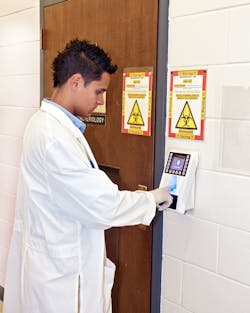Biometrics became far more visible and contemporary during 2014, and its continuing integration into everyday life is moving the industry toward its long-time goal of eliminating the hassle and security risks of PINs and passwords by making it easier to know if someone is who he or she claims to be.
Users will have more and more options for combining convenience with security through the latest biometrics solutions, and integrators will find themselves being asked not just to secure their customers’ facilities, but to improve the security experience, as well. As the biometrics authentication model grows in popularity along with the value of the transactions it protects, there will be new pressures on integrators to provide even better and more convenient security.
There are a number of developments under way — with sensors that deliver even better security, privacy, encryption, tamper protection and anti-spoofing capabilities. Integrated biometrics readers will authenticate both the card and the user carrying it, using advanced sensor technology that improves image quality and spoof protection. Biometric templates will also move along with user IDs onto mobile devices for significantly improved convenience and security. And we will see geolocation and time synchronization technology used to coordinate an individual’s multiple types of fingerprint, iris and other biometric IDs across multiple interconnected mobile and wearable devices — delivering near-perfect personal authentication accuracy in Internet of Things applications. Meanwhile, credential delivery and management will grow in importance, using cloud-based solutions into which all entities have been biometrically authenticated.
The umbrella covering all of these developments, though, will be a sharper focus on the user experience, in which security is a guardrail rather than a barrier — with the potential to change everything from the way we bank and purchase items to how our businesses, hospitals and other facilities are built and operated. Integrators who understand this trend will be able to give their customers a seamless and frictionless environment in which they can conveniently and securely do their jobs or safely go about their business. Here are the top trends for integrators to watch in each market segment:
Government ID
The industry is quickly moving to solutions that integrate fingerprint sensors into readers capable of verifying the authenticity of a driver’s license, Green Card, passport or other ID card, as well as the individual that is carrying it. In the border control infrastructure, the benefits of incorporating automated biometrics clearance using integrated solutions include strengthening security and flexibility, increasing capacity and passenger throughput, and reducing cost per transaction.
Integrated solutions will also deliver benefits in other civil or national ID programs including document issuance, voter registration, and public distribution of goods and services. The choice of sensor technology will continue be important because of the operational conditions and heavy duty cycles of many e-border and other government ID applications, as well as the volume demands of automated clearances requiring large-scale matching.
Additionally, governments and other organizations will need to adopt best practices that define the collection, use and sharing of biometric data, while also addressing such system-level considerations as encryption and tamper-resistant hardware that helps combat unauthorized intrusion.
Corporate
Among other uses in today’s business environment, biometrics will move into secure printing applications, making it easier to protect documents by requiring users to authenticate with a card, badge or finger. With a very simple way to implement multi-factor authentication before documents are released to the hopper, enterprises will not only improve security, but ensure that operating costs for copying, faxing, scanning or printing are dramatically reduced and more effectively managed.
The enterprise environment will also likely be one of the first places where biometrics emerges on mobile devices. The industry already values the benefits of storing fingerprints and other biometric templates on physical smartcards, and these benefits also apply to smartphones or other devices carrying mobile IDs, which will pave the way for new capabilities like continuously reading a person's biometrics as he or her carries a mobile phone, and pre-authenticating the person before he or she gets to the door.
Healthcare
Biometrics will play a big role in how hospitals register patients, manage visitors, protect patient information privacy, process payments and ensure accurate medicine dispensing while eliminating drug diversion, among other daily activities. During 2015 and beyond, integrators will be asked to replace their customers’ dated and vulnerable authentication models with biometric authentication that, for example, ensures health information may only be accessed by authorized individuals.
While smartcards have typically provided a strong security authentication solution for enterprise single sign-on (ESSO) to health records or electronic prescriptions, they rely on a PIN, and can be forgotten and/or stolen — which can also be said of future solutions on smartphones. As an alternative, biometrics solutions will emerge that, with the simple touch of a finger, enable users to reliably authenticate themselves and log into multiple applications while providing an irrefutable audit trail.
Integrators serving healthcare providers will need to help them evaluate a wide range of seamlessly integrated biometrics choices in order to more effectively do their jobs — across the full spectrum of security requirements from credential management to identity assurance.
Banking
Biometrics will continue to proliferate throughout the worldwide banking infrastructure, improving the customer experience while increasing the security of ATM and other transactions. Biometric ATMs will grow in popularity worldwide, and during the coming year, countries like Brazil will even see the number of ATMs with biometric authentication overtake those relying only on conventional approaches.
Meanwhile, financial institutions are poised for innovative new security capabilities in 2015 and beyond. Biometrics performance, reliability and spoof-protection capabilities will continue to be particularly important for unattended transactions like those conducted at ATM terminals, and we see integrated biometric readers that improve security for applications including account origination and online authentication.
Another area for integrators to watch during 2015 and beyond is tamper-proof, encrypted solutions for biometric authentication that allow for end-to-end security and the protection of biographic and biometric data.
Transportation
Biometric systems will continue to offer integrators the opportunity to help customers in the transportation industry increase both security and profits. Sensors will deliver better security, privacy, encryption, tamper protection and anti-spoofing capabilities. As in other sectors, there will be developments in geolocation solutions that coordinate biometric IDs across multiple mobile and wearable devices, and cloud-based credential delivery and management in which all entities are biometrically authenticated. Plus, the industry will continue to improve the user experience, even while it reduces increasingly dangerous threats to the transportation infrastructure.
Biometrics technology will migrate into consumer transportation applications as well — moving beyond industrial driver identification applications focused on safety and security (i.e., ensuring that the person driving the forklift or operating the crane is authorized to do so) to personal driver identification solutions that not only enhance safety (i.e., restricting a teen driver’s speed and operating hours) but also deliver new capabilities (i.e., authenticating users for transactions related to connected-car applications).
Retail
Integrated biometric readers will drive improvements in identity verification for cards used in payment and loyalty programs, increasing their use and functionality. Biometrics will also play a role as the industry continues to combat high-profile retail breaches that highlight the vulnerability of current authentication solutions at the point of sale (POS).
While new types of credentials based on smartcard technology will dramatically improve security, even more effective solutions are possible using the same biometric technology that is already authenticating both the credential and the person carrying it at popular theme parks and in banking and other applications. Only a biometric can establish who is actually present for a transaction, and the coming generation of POS applications will include fingerprint authentication to ensure that only authorized people are approving transactions.
Meanwhile, inside the store, integrators will increasingly be called on to help their customers adopt biometrics solutions for time-and-attendance applications, eliminating the problems of employees sharing, swapping, stealing and/or losing their PINs, passwords and ID cards.
Higher Education
Integrators serving universities will need to address new types of more rigorous security requirements, such as those related to R&D labs and similarly sensitive environments — especially those that conduct experiments with dangerous chemicals, biological agents, radioactive materials and pathogens. Laboratory security systems must ensure overall safety for laboratory personnel, the public and animal test subjects, improve planning for emergency preparedness and incident response, and lower an organization’s liability.
Even identifying individual students who may be remotely linked to a college or university and taking exams could help promote a more affordable online curriculum for some. Leveraging world class instructors and securely extending online courses will benefit both students and participating institutions. This may also require extending the value of current contactless identity cards by using biometrics to more quickly, reliably and effectively verify the authenticity of an ID card and the person carrying it.
Campus ID cards of the future will be used with biometric authentication solutions such as those that integrate fingerprint sensors with contactless card-reading technology, and will migrate to mobile devices and fingerprint-only access control solutions that will redefine the concept of the student or staff ID card.
Phil Scarfo is Vice President of Biometrics Global Marketing for HID Global. To request more info about the company, please visit www.securityinfowatch.com/10213866.



